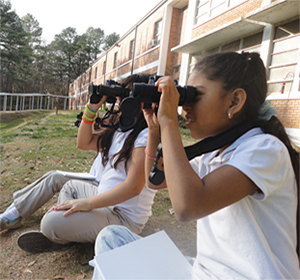
Audubon Adventures
Raptors: The Birds of Prey

Activities
 Activity 3
Activity 3
Eagle-Eyed Raptors
 Teacher-led Classroom/Field Activity
Teacher-led Classroom/Field Activity
Science/Research/Writing

Students take a look at how raptors see the world.
Objective
Students consider the world from a raptor’s viewpoint and write poems based on the experience.
Students will need:
-
Binoculars
-
A newspaper, book, or magazine with clear printing
-
Paper, pens and/or computer access
-
Outdoor space, such as a playground, schoolyard, or park
Suggested time:
One class period outdoors, plus writing time either in class or at home
What to do
-
As a class, discuss the adaptations of raptors after students have had the opportunity to read the Audubon Adventures magazine “Raptors! The Birds of Prey.” What is significant about the eyesight of daytime raptors?
-
Tell students they will be going outside to see what it’s like to view the world with “eagle eyes.” Then divide students into teams or pairs (depending on how many pairs of binoculars are available).
-
Outside, have students stand in one area while you hold the printed material aloft from across a wide space, depending on how large the print size is. Students should not be able to read the material without using the binoculars.
-
Have each pair or team of students swap binoculars so that each student gets a chance to see the printed material with and without the use of binoculars.
-
Back in class, talk about the experience. A raptor’s eyes don't magnify images the way binoculars do, but they are certainly able to see much greater detail at a distance than our eyes can. This is because of adaptations in the structure of their eyes. By using binoculars, we can get a sense of how eagle-eyed raptors are.
Photos: Jim Verhagen; Toyota TogetherGreen




